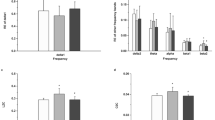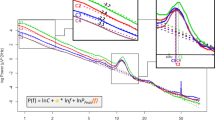Abstract
Conventional sleep analysis according to Rechtschaffen and Kales (1968) has provided meaningful contributions to the understanding of disturbed sleep architecture in depression. However, there is no characteristic alteration of the sleep cycle, which could serve as a highly specific feature for depressive illness. Therefore, we started to investigate nonlinear properties of sleep electroencephalographic (EEG) data in order to elucidate functional alterations other than those obtained from classical sleep analysis. The application of methods from nonlinear dynamical system theory to EEG data has led to the assumption that the EEG can be treated as a deterministic chaotic process. Chaotic systems are characterized by a so-called sensitive dependence on initial conditions. This property can be quantified by calculating the system's Lyapunov exponents, which measure the exponential separation of nearby initial states in phase space. For 15 depressive inpatients (major depressive episodes according to DSM-III-R criteria) and 13 healthy controls, matched in gender, age, and education, we computed the principal Lyapunov exponents L1 of EEG segments corresponding to sleep stages I, II, III, IV, and rapid eye movement (REM), according to Rechtschaffen and Kales, for the lead positions CZ and PZ. We found statistically significant decreased values of L1 during sleep stage IV in depressives compared with a healthy control group.
Similar content being viewed by others
References
Achermann P, Hartmann R, Gunzinger A (1993) Dimensional analysis of all night sleep EEG data. APSS annual meeting, abstract 47
Achermann P, Hartmann R, Gunzinger A, Guggenbuhl W, Borbély AA (1994) All night sleep EEG and artificial stochastic control signals have similar correlation dimensions. Electroencephalogr Clin Neurophysiol 90:384–387
American Psychiatric Association (1987) Diagnostic and statistical manual of mental disorders (DSM-III-R), 3rd edn, revised. American Psychiatric Press, Washington, DC
Babloyantz A, Nicolis C, Salazar U (1985) Evidence of chaotic dynamics. Phys Lett A 111:152–156
Babloyantz A, Destexhe A (1986) Low-dimensional chaos in an instance of epilepsy. Proc Natl Acad Sci USA 83:3513–3517
Basar E (ed) (1990) Chaos in brain function. Springer, Berlin Heidelberg New York
Beersma DG, Hoofdakker RH van den (1992) Can non-REM sleep be depressogenic? J Affect Disord 24:101–108
Benca RM, Obermeyer WH, Tiested RA, Gillin JC (1992) Sleep and psychiatric disorders. A meta-analysis. Arch Gen Psychiatry 49:651–668
Borbély AA, Wirz-Justice A (1982) Sleep, sleep deprivation and depression. A hypothesis derived from a model of sleep regulation. Hum Neurobiol 1:205–210
Borbély AA, Tobler I, Loepf M, Kupfer DJ, Ulrich RF, Grochocinski V, Doman J, Matthews G (1984) All-night spectral analysis of sleep EEG in untreated depressives and normal controls. Psychiatry Res 12:27–33
Eckmann JP, Ruelle D (1985) Ergodic theory of chaos and strange attractors. Rev Mod Phys 57:617–656
Ehlers CL, Havstad JW, Garfinkel A, Kupfer DJ (1991) Nonlinear analysis of EEG sleep states. Neuropsychopharmacology 5: 167–176
Fell J, Röschke J, Beckmann P (1993) Deterministic chaos and the first positive Lyapunov-exponent: a nonlinear analysis of the human electroencephalogram during sleep. Biol Cybern 69: 139–146
Fell J, Beckmann P (1994) Resonance-like phenomena in Lyapunov-calculations from data reconstructed by the time-delay-method. Phys Lett A 190:172–176
Fell J, Röschke J (1994) Nonlinear dynamical aspects of the human sleep EEG. Intern J Neurosci 76:109–129
Frank GW, Lookman T, Nerenberg MAH, Essex C, Lemieux J, Blume W (1990) Chaotic time series analyses of epileptic seizures. Physica D 46:427–438
Gallez D, Babloyantz A (1991) Predictability of human EEG: a dynamical approach. Biol Cybern 64:381–391
Garfinkel A (1983) A mathematics for physiology. Am J Physiology 245:R455-R466
Gorman M (1993) Classification of high-dimensional chaotic dynamics using power spectra. In: Jansen B, Brandt M (eds) Nonlinear dynamical analysis of the EEG. World Scientific, Singapore, pp 3–12
Graf KE, Elbert T (1989) Dimensional analysis of the waking EEG. In: Basar E, Bullock T (eds) Brain dynamics. Progress and perspectives. Springer, Berlin Heidelberg New York, pp 174–191
Grassberger P, Schreiber T, Schaffrath C (1991) Nonlinear time sequence analysis. Int J Bifurcation Chaos 1:251–547
Goldberger AL, West BJ (1987) Applications of nonlinear dynamics to clinical cardiology. Ann NY Acad Sci 504:195
Haken H (1983) At least one Lyapunov-exponent vanishes, if the trajectory of an attractor does not contain a fixed point. Phys Lett A 94:71–72
Horne JA (1993) Human sleep, sleep loss and behavior. Br J Psychiatry 162:413–419
Iasemidis LD, Sackellares JC (1991) The evolution with time of the spatial distribution of the largest Lyapunov-exponent on the human epileptic cortex. In: Pritchard WS, Duke DW (eds) Measuring chaos in the human brain. World Scientific, Singapore, pp 49–82
Krystal AD, Weiner RD (1991) The largest Lyapunov-exponent of the EEG in ECT seizures. In: Pritchard WS, Duke DW (eds) Measuring chaos in the human brain. World Scientific, Singapore, pp 113–127
Kupfer AD, Reynolds CF (1989) Slow wave sleep as a protective factor. In: Stunkard AJ, Baum A (eds) Eating, sleeping and sex. Lawrence Erlbaum, New Jersey, pp 131–145
Lutzenberger W, Birbaumer N, Flor H, Rockstroh B, Elbert T (1992) Dimensional analysis of the human EEG and intelligence. Neurosci Lett 143:10–14
Mayer-Kress G, Holzfuss J (1987) Analysis of the human electroencephalogram with methods from nonlinear dynamics. In: Rensing L, Heiden U van der, Mackey MC (eds) Tempral disorder in human oscillatory systems. Springer, Berlin Heidelberg New York, pp 57–68
Molinari L, Dumermuth G (1993) Once more: dimension and Lyapunov exponents for the human EEG. In: Jansen B, Brandt M (eds) Nonlinear dynamical analysis of the EEG. World Scientific, Singapore, pp 140–165
Nan X, Jinghua X (1988) The fractal dimension of EEG as a physical measure of conscious human brain activation. Bull Math Biol 50:559–565
Ott E, Grebogi C, Yorke JA (1990) Controlling chaotic dynamical systems. In: Campbell K (ed) Chaos/xaoc — Soviet-American perspectives on nonlinear science. American Institute of Physics, pp 153–171
Palus M (1993) Testing for nonlinearity in the EEG. In: Jansen B, Brandt M (eds) Nonlinear dynamical analysis of the EEG. World Scientific, Singapore, pp 100–115
Parlitz U (1991) Identification of true and spurious Lyapunov exponents from time series. Int J Bifurcation Chaos 2:155–165
Pesin YB (1977) Characteristic Lyapunov-exponents and smooth ergodic theory. Russ Math Surv 32:55
Pijn JP, Van Neerven J, Noest A, Lopes da Silva FH (1991) Chaos or noise in EEG signals; dependence on state and brain site. Electroencephalogr Clin Neurophysiol 79:371–381
Pool R (1989) Is it healthy to be chaotic? Science 243:604–607
Principe JC, Lo PC (1991) Towards the determination of the largest Lyapunov-exponent of EEG segments. In: Pritchard WS, Duke DW (eds) Measuring chaos in the human brain. World Scientific, Singapore, pp 156–166
Pritchard WS, Duke DW (1992) Dimensional analysis of no-task human EEG using the Grassberger-Procaccia method. Psychophysiology 29:182–192
Rapp PE, Albano AM, Mees AI (1988) Calculation of correlation dimensions from experimental data. Progress and Problems. In: Kelso JAS, Mandell AJ, Schlesinger MF (eds) Dynamic patterns in complex systems. World Scientific, Singapore, pp 191–205
Ray WJ, Wells R, Elbert T, Lutzenberger W, Birbaumer N (1991) EEG and chaos: dimension estimation of sensory and hypnotic processes. In: Pritchard WS, Duke DW (eds) Measuring chaos in the human brain. World Scientific, Singapore, pp 199–215
Rechtschaffen A, Kales A (1968) A manual of standardized terminology, techniques and scoring system for sleep stages of human subjects. Public Health Service, Washington DC, NIH Publication No. 204, U. S. Government Printing Office
Reynolds CF, Kupfer DJ (1987) Sleep research in affective illness: state of the art circa 1987. Sleep 10:199–215
Röschke J, Aldenhoff JB (1991) The dimensionality of human's electroencephalogram during sleep. Biol Cybern 64:307–313
Röschke J, Mann K, Fell J (1994) Nonlinear EEG dynamics during sleep in depression and schizophrenia. Intern J Neurosci 75: 271–284
Röschke J, Fell J, Beckmann P (1994) Nonlinear analysis of sleep EEG data in schizophrenia: calculation of the principal Lyapunov-exponent. Psychiatry Res (in press)
Skarda C, Freeman W (1987) How brains make chaos in order to make sense of the world. Behav Brain Sci 10:161–195
Soong ACK, Stuart CIJM (1989) Evidence of chaotic dynamics underlying the human alpha-rhythm electroencephalogram. Biol Cybern 62:55–62
Takens F (1981) Detecting strange attractors in turbulence. Lect Notes Math 898:366–381. Springer, Berlin Heidelberg New York
Wolf A, Bessoir T (1991) Diagnosing chaos in the space circle. Physica D 50:239–258
Wolf A, Swift JB, Swinney HL, Vastano JA (1985) Determining Lyapunov exponents from a time series. Physica D 16:285–317
Author information
Authors and Affiliations
Rights and permissions
About this article
Cite this article
Röschke, J., Fell, J. & Beckmann, P. Nonlinear analysis of sleep eeg in depression: Calculation of the largest lyapunov exponent. Eur Arch Psychiatry Clin Nuerosci 245, 27–35 (1995). https://doi.org/10.1007/BF02191541
Received:
Accepted:
Issue Date:
DOI: https://doi.org/10.1007/BF02191541




